It’s no secret that having good balance in paddleboarding offers a huge advantage when trying to get into the sport.
There are off course other factors which influence the success and ultimately enjoyment of your paddleboarding experience, but balance certainly has to be up there as one of the most important factors.
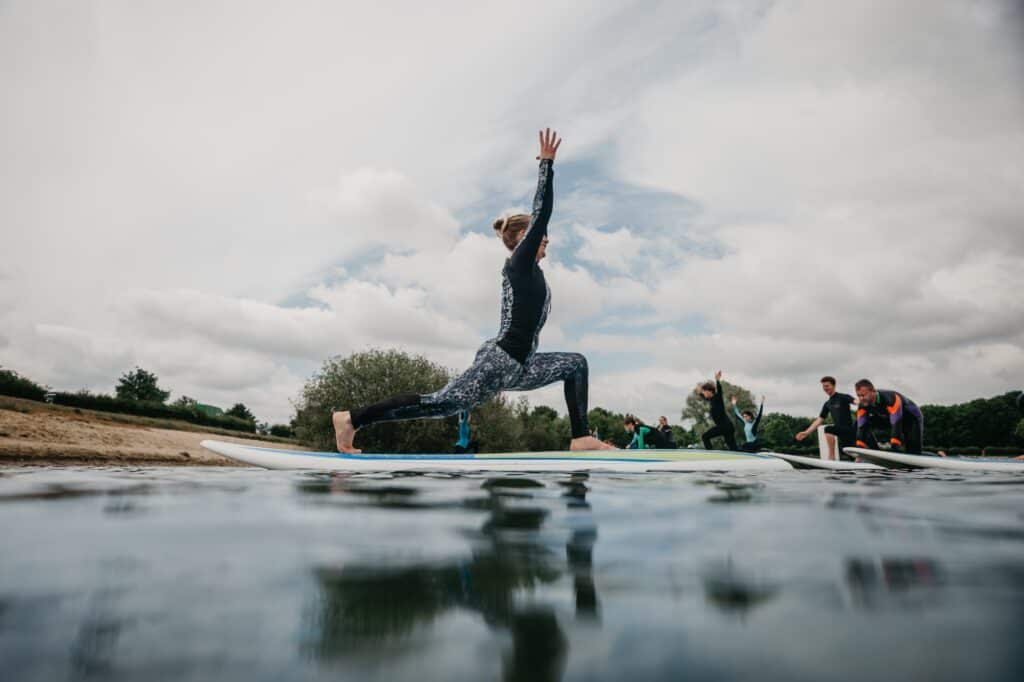
Fortunately balance is in fact something we can train and by doing exercises and activities which closely relate to the movements you will likely do in paddleboarding we can train our muscles and muscle memory to greatly improve our balance.
The key to improving your balance for paddleboarding is strengthening your lower body and your core. Your core is one of the most vital components to ensuring you can maintain a good centre of gravity.
Now you could go to the gym, load up the squat rack and start grunting away as you force up heavy weights, whilst this is good strength training for the legs and lower back, it isn’t very task oriented.
We can actually improve our leg strength and core strength whilst performing more task specific movements, this will offer us the best improvement.
Fortunately to carry out a lot of these exercises you really don’t need much equipment either.
In fact all of these exercises can be completed using the following pieces of equipment.
Bosu Ball
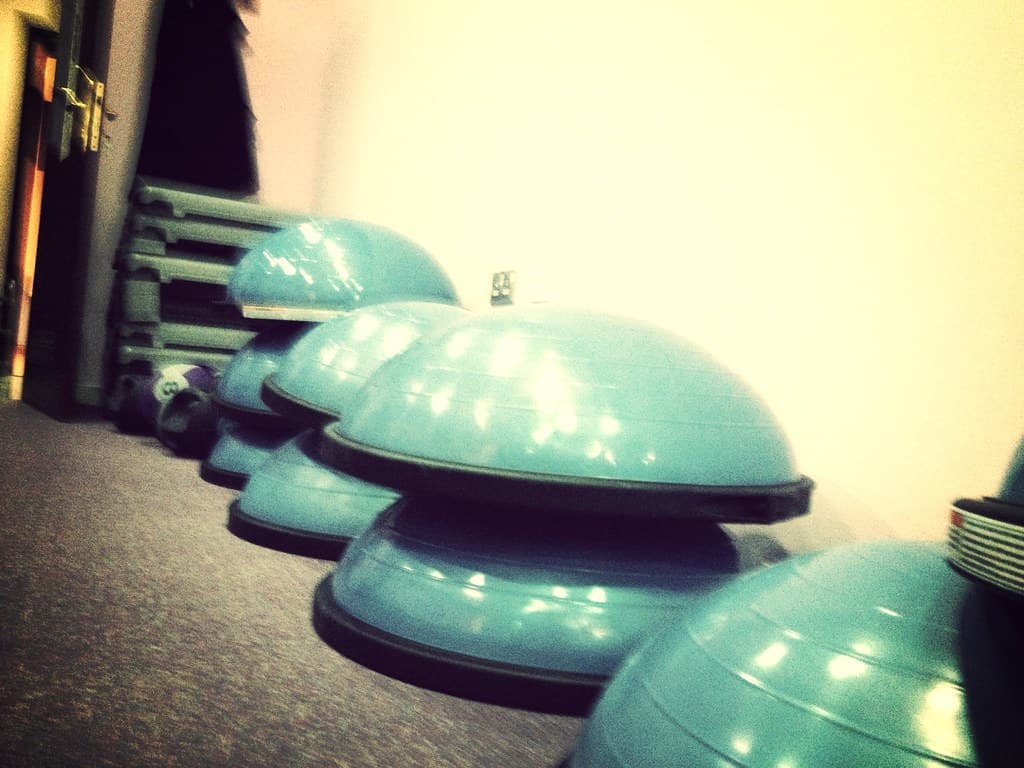
Dyna Band (Resistance Band)

Paddle
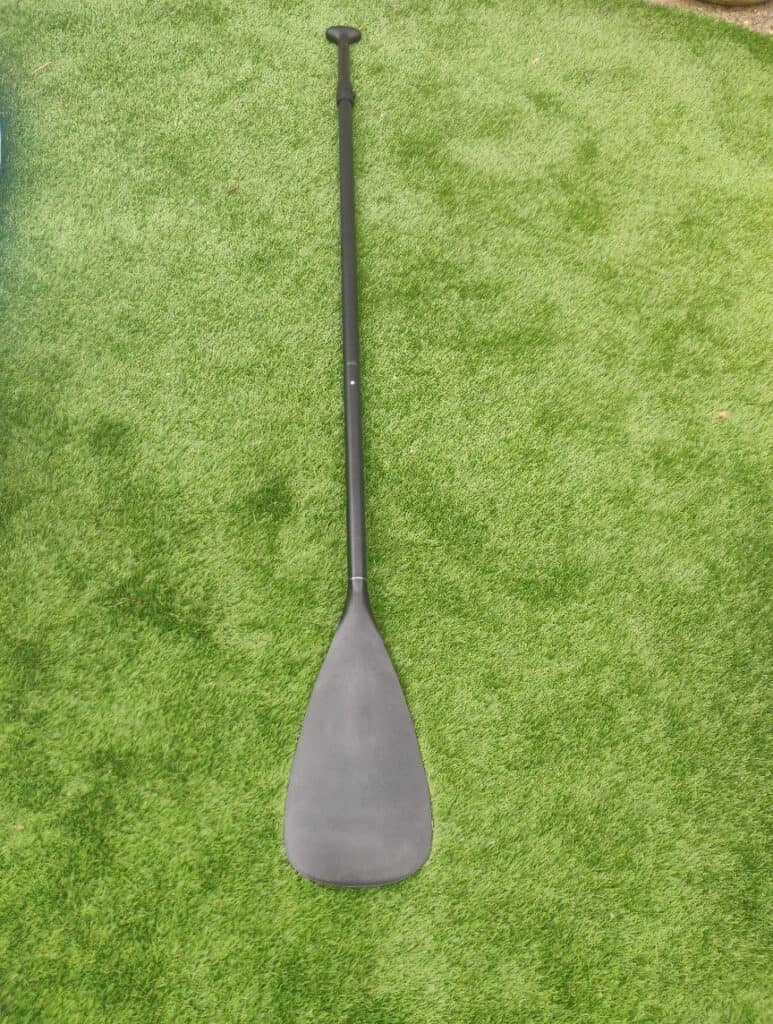
That’s it, just those three things.
Now I will go on later to talk about specific balance trainers but these are by no means a requirement.
Exercise 1 – Bosu Ball Balance
The first exercise is extremely simple and is designed for those who either suffer with balance, have a previous injury that they must be mindful of, or they are not very experienced with bosu balls and how they move.
The first exercise we are going to do is simply standing on the bosu ball and attempting to balance until the bosu ball is in a still stable position.
As you become more comfortable on the bosu ball and you are able to get a still motion relatively quickly then you can start manipulating the bosu ball yourself by moving side to side or forwards and backwards.
By forcing your weight in these directions and then working quickly to rebalance yourself you can get significant benefits to your balance ability as it trains your muscles to be able to cope with sudden subtle motions.

Once you are comfortable with all the moves and motions of the bosu ball we can start to progress the exercises.
Pro Tip – if you bend your knees slightly while keeping your weight firmly planted over the centre of your stance it will make controlling the wobbly of the bosu ball much easier and keep your more balanced.
Exercise 2 – Bosu Ball Squat
The Bosu ball squat is a great progression exercise once you have mastered balancing on the bosu ball.
To perform the exercise you want to first step onto the bosu ball with your feet just over shoulder width apart.
Once in position you will want to perform a traditional squat ensuring the correct squatting technique is used to not only get the best benefits but also to ensure you do not cause unnecessary strain or injury.
To perform a squat you will want to start by slightly bending your knees, from this position you want to bring your bum towards the ground ensuring you keep your back straight at all times.
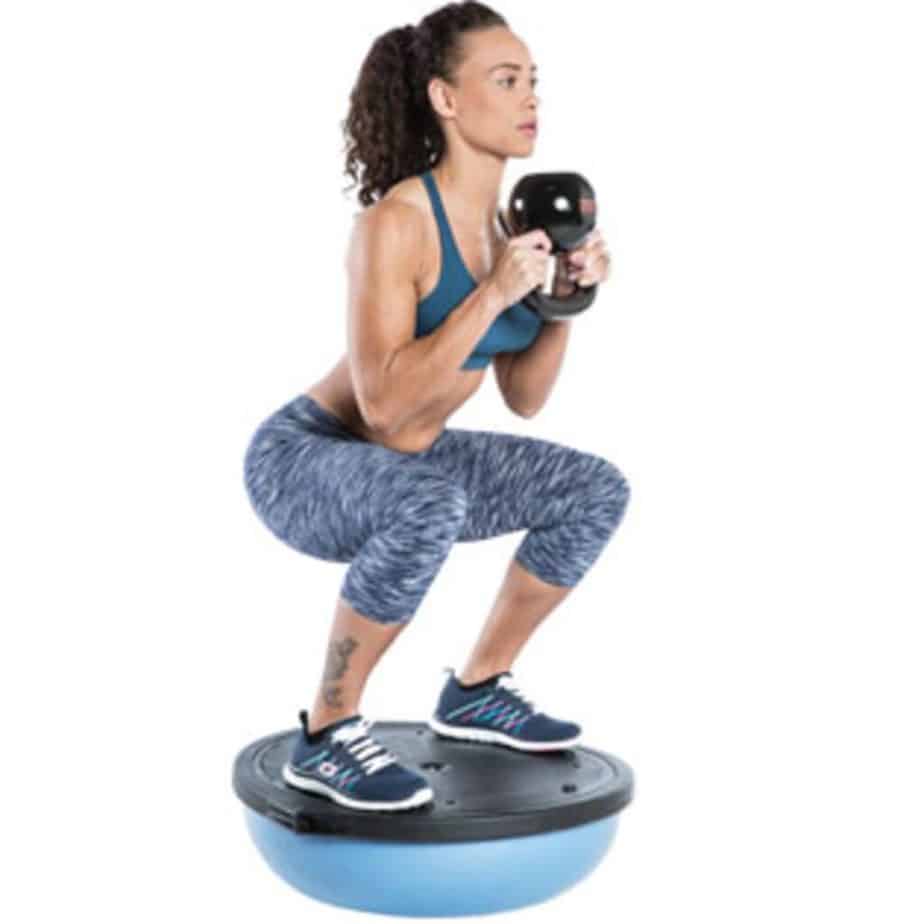
As you get lower you will feel your heels wanting to lift off the ground, this normally indicates you are nearing the end of your range of motion, when you hit this point you gradually stand straight upright again ensuring your back stays straight.
The benefits to doing this on a bosu ball is because the surface is unstable it causes your core to engage a lot more than it otherwise would.
Engaging and strengthening your core is the best way to improve your overall balance.
As we begin to build strength and familiarise ourselves with balancing on a constant moving platform we can really start to get specific with our exercises to ensure they are as beneficial as possible for paddle boarding.
Exercise 3 – Bosu Ball – Front Row
The more we practice on the bosu ball the easier you will find rebalancing and centering yourself under your own manipulation movements.
This is where we can start to introduce the resistance band to offer a greater deal of randomisation and difficulty to the exercise.
Position the bosu ball approximately 50cm away from a solid anchor or tie point and then secure one end of the resistance band to the anchor point.
Take your stance on the bosu ball with the loose end in hand.
Start balancing on the bosu ball and find a stable position.
Once the ball has stabilised take the resistance band in both hands and using only your shoulders lift the dyna band directly above the head.
The key to this movement is to try and keep your arms as straight as possible and allow your shoulders and back to perform the majority of the task.
As the resistance band gets more stretched out and higher from our body you will find your core and legs working harder to keep you stable and balanced.
This exercise is fantastic for not only strengthening your shoulders ready for them long paddles but it also does wonders for strengthening your core and lower back.
To make the exercise more difficult move the bosu ball further away from the anchor point to increase the resistance.
Exercise 4 – Bosu Ball – Standing Rows
Now we start getting into the targeted exercises.
Now we are feeling comfortable on a bosu ball staying in our centre of gravity we can start performing exercises that force out of our body line a bit more.
The first exercise I would suggest starting with is a standing row whilst standing on the bosu ball.
To perform this set up your bosu ball approximately 50cm away from a solid anchor or tie point.
Secure your resistance band to the tie or anchor point, ideally at head height.
Once the resistance band is tied off, take the loose end and stand on the bosu ball ready to start the exercise.
Shift your weight to ensure you are balancing on the bosu ball and begin a row motion with the resistance band, do several repetitions on one side before switching to the opposite arm.
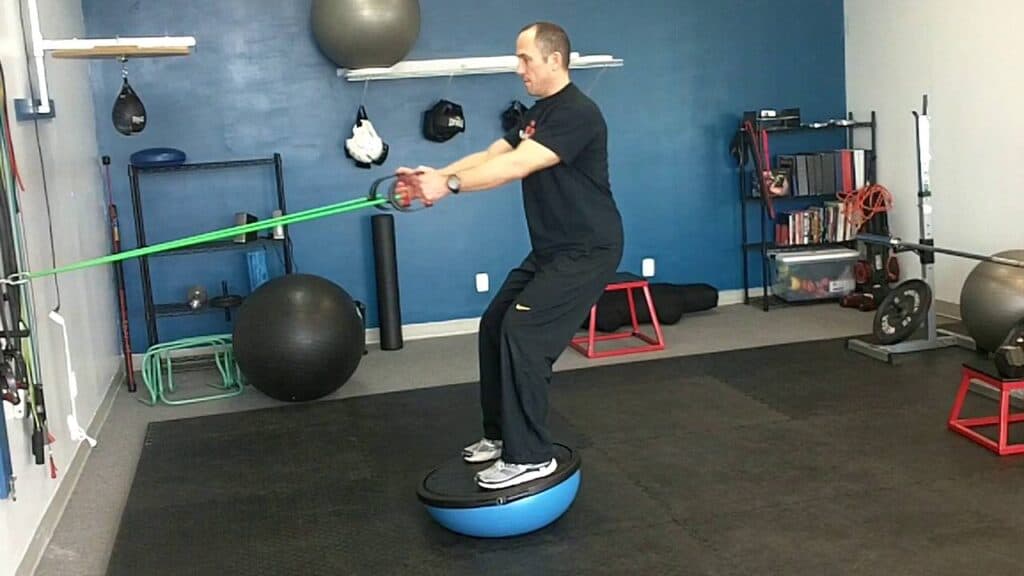
This exercise mimics the first phase of paddling, it is fantastic at helping you stay balanced whilst reaching forward slightly to start your paddle.
If you find the exercise too easy, move your bosu ball further away from the anchor point to increase the resistance from the band.
Exercise 5 – Bosu Ball – Trunk Twists
This exercise is another variation and progression exercise to the one noted above.
Starting again approximately 50cm away from your anchor point with your resistance band tightly secured, take position on your bosu ball.
When on the bosu ball you take your resistance band in one hand, pull the resistance towards your body and then through behind you, as you do this you want to open your body outwards the same direction as your resistance band.
As you twist the trunk of your body through with the resistance band bring your opposite arm forward and stretch outwards.
Once complete slowly begin to untwist your body and finish back in the square central position.
Repeat the process for several repetitions before switching to the opposite side.
Although it is unlikely you will ever twist and extend this dramatically in paddleboarding you will twist to some degree to finish off the stroke.
Twisting into the paddle slightly also allows you to stroke for longer and with more power which increases the speed in which you paddle.
This exercise is certainly an exaggeration of any paddleboarding movements but it does mimic the middle and end phases of the stroke when paddling.
Exercise 6 – Bosu Ball – Paddling
Now it terms of targeted specific exercises it really doesn’t get any closer than this.
Keeping the resistance band tied to the anchor point, take the loose end of the resistance band and tie it to your paddleboard paddle just above the blade of the paddle.
Once complete position your bosu ball approximately 50cm away from your anchor point and get in a ready position on the ball with your paddle in hand.
Once you are stable and balanced on the bosu ball with your paddle in hand as if you were paddling on the water we can start the exercise.
To perform the exercise simply paddle as you would if you were on the water whilst balancing on the bosu ball.
Repeat the process on one side for several repetitions before switching sides.
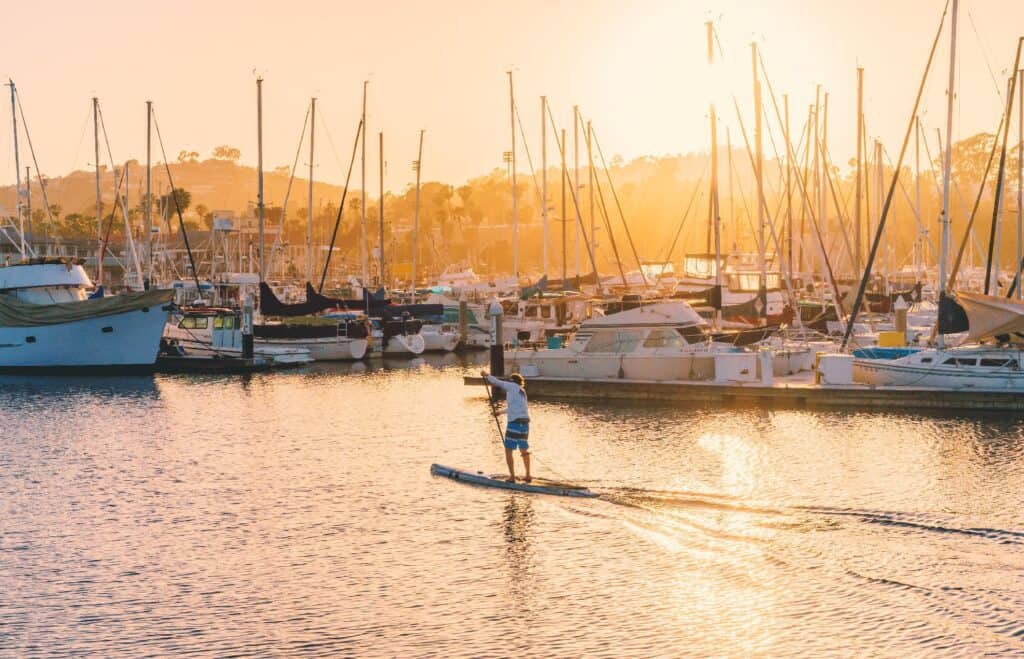
You can even switch this up and perform 2-3 strokes on each side as if you were really out paddling.
Much like with the other activities using the resistance band you can increase the difficulty by moving the bosu ball further away from the anchor point to increase the resistance.
Adaptations For Greater Difficulty
The above exercises are meant to be progression exercises. Each exercise gets more and more challenging allowing people of all levels to improve their balance and ultimately their paddleboarding ability and enjoyment.
If you however, you breezed through all of these activities but you liked the exercises themselves in terms of what they offer for your paddleboarding strength and conditioning there are actually a few different ways in which we can increase the difficulty.
Single Leg Exercises
The first and easiest way to drastically improve the difficulty of the above exercises is to carry out each of them single leg.
What I mean by this is if you lift one leg up off the ground so you are balancing solely off one leg.
This is a fantastic way of not only making the exercises more challenging but may also highlight weakness on one side that you never realised you had.
It is quite common for your more dominant side to carry a weaker side, by training each side individually you can determine if there are any weaknesses and work on balancing them out.
Use an Exercise Ball
Another way that you can really up the ante on these exercises is by swapping out the bosu ball for a trickier platform.
When it comes to things you can stand on to challenge yourself there really isn’t anything more challenging than a traditional exercise ball.
With that being said prior to carrying out any of these exercises using the exercise ball it is important that you first ensure your surroundings are safe and that you build up to standing on the exercise ball.
Getting into a standing position on an exercise ball is much trickier than the bosu ball so please ensure due care is taken before taking on the exercise ball.
Now we have the public safety announcement out the way we can talk a bit more about the exercise ball.
As the exercise ball is circular in shape it doesn’t offer any flat sections for us to stand on, the surface is also flexible meaning we never had a solid platform to stand on.
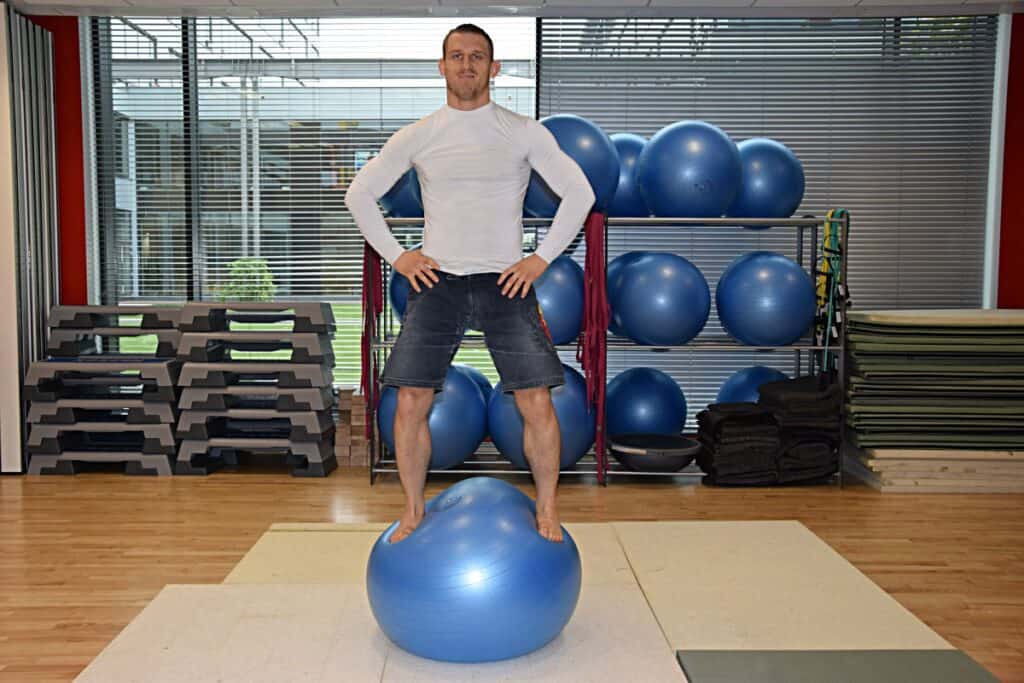
Being circular it also means it moves around a lot more frequently and any micro adjustments are felt a lot more than they otherwise would on a bosu ball.
If you are somewhat of a paddleboard expert and you know you have the strength and experience to be able to handle the exercise ball why not challenge yourself?
Exercise 7 – Bosu Ball – Close stance Paddling
You may be a bit surprised to see another exercise listed after I just talked about how you can make all these exercises more difficult.
Well this exercise only really works on something like a bosu ball and therefore it couldn’t really be included in the other exercises and whilst it is another way of making the above more difficult it can actually be treated as an entirely separate exercise.
If you want to practice and work on your balance for when it is particularly choppy or unstable you can use the paddle exercise however, this time you want to stand on the bosu ball with your feet very close together.
By having your stance very close together it makes balancing much more challenging.
It also means the bosu ball moves for frequently and generally more aggressively and sharply.
If you really want to test and improve your balance, next time you try the paddle exercise on the bosu ball, keep your feet closer together.
The closer together your feet the more challenging this exercise becomes.
Balance trainers
If you aren’t particularly creative and just want a piece of equipment that is specifically designed to improve your balance then you may just want to jump straight to purpose built balance trainers.
There are actually a variety of balance trainers on the market but by far the most popular is the Indo board.
Indo boards
The Indo board was originally invented in the early 70’s by surfer Hunter Joslin.
It was designed to offer a practical way to practice balance and technique for surfing whilst staying indoors.
Thanks to its simplicity and versatility it quickly became a multi-function piece of equipment offering benefits to just about any sport you think of.
The Indo Board offers the following benefits:
- Increased core strength
- Increased leg strength
- Balance coordination
These are the basic benefits to using the Indo board however couple the Indo board with some additional pieces of equipment and you get much more than a core fitness trainer. Using the other equipment you fully exercise your upper body and lower body.
The Indo board is an oval piece of wood normally birch ply or bamboo laminate with a stop block at each end.
The Indo board sits on top of a plastic moulder roller that usually contains strips of grip tape to ensure the indo board does not slip or slide when in use.
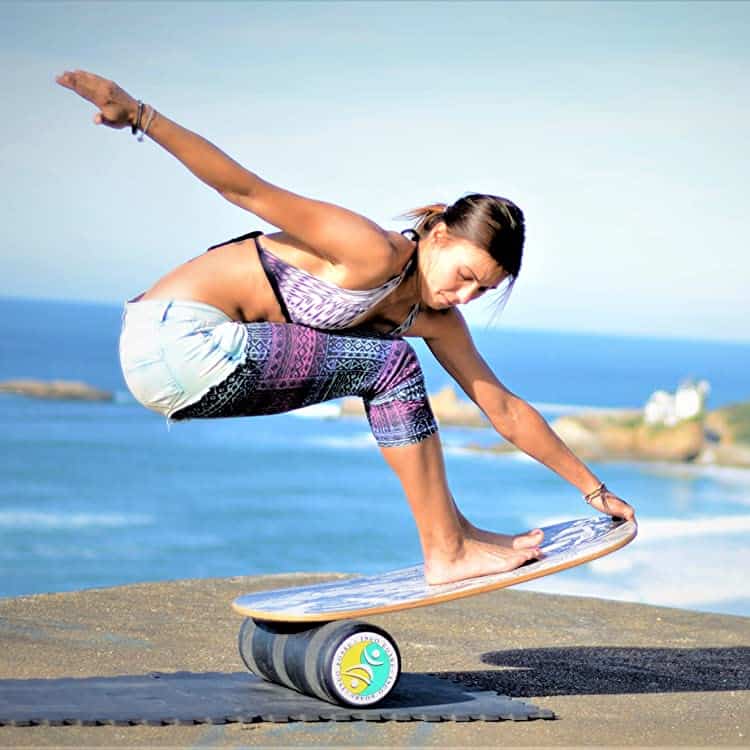
The complete Indo board package also comes with a polyvinyl balance cushion with a circular cushion that can be used for multi-directional movement.
Indo boards are a fantastic way to work on your balance and being specifically designed for watersports it is probably the best trainer you can get short of doing the real thing.
I have put a video below showing you how you can use your Indo board to improve your balance for all watersports.
If you want to purchase your own Indo board you do so by clicking the below affiliate link.
This link will take you straight to Amazon where you can check out the latest prices
If you have just clicked the link and fell off your chair because of the price fear not as there is an alternative to still get a balance trainer at a good price, although it does require you to be somewhat handy and resourceful.
Make your own balance trainer
Thanks to their extremely simple but effective design Indo boards can actually be built by anyone using relatively cheap materials.
If you are handy with tools and have the capabilities of buying the materials below, you can easily make and design your very own indo board.

The materials you will need to make your own Indo board are as follows:
- 18mm ply (preferably birch ply if you can afford it)
- 1 length of timber (This is to form the stop blocks)
- Section of Drainage Pipe
- Grip tape
- Sand
- Varnish
Simply cut down the ply to a suitable size, the original Indo board measures 76cm long by 45cm wide.
If possible you want to cut the ply into an oval shape and then sand down the edges to ensure there are no splinters etc..
Once you have made your board you will want to cut down the length of cls to form two stop blocks, ensure the stop blocks are the same width as the board at each end.
Once you have cut down the CLS fix one length at one end of the board and the other at the opposite end. It is easiest to screw these into place.
Next get your section of drainage pipe and cut it down so that is slightly wider than the widest part of your board.
Once it is cut to size you will want to wrap this grip tape. This can be done by cutting the grip tape into multiple strips or you can simply wrap the whole thing, it is entirely your choice.
Lastly evenly distribute the sand across the top of your board and then varnish over the top of the whole thing.
The purpose of this is to create a stippled surface on top of the board that creates friction between you and the board, this will allow you to better grip to the top of the board when using it.
Allow everything to settle/ cure accordingly and boom you’re done.
You can now start playing around with your own personalised Indo Board.
If you didn’t quite follow along with my description I have found a really helpful video online which you can see below.
